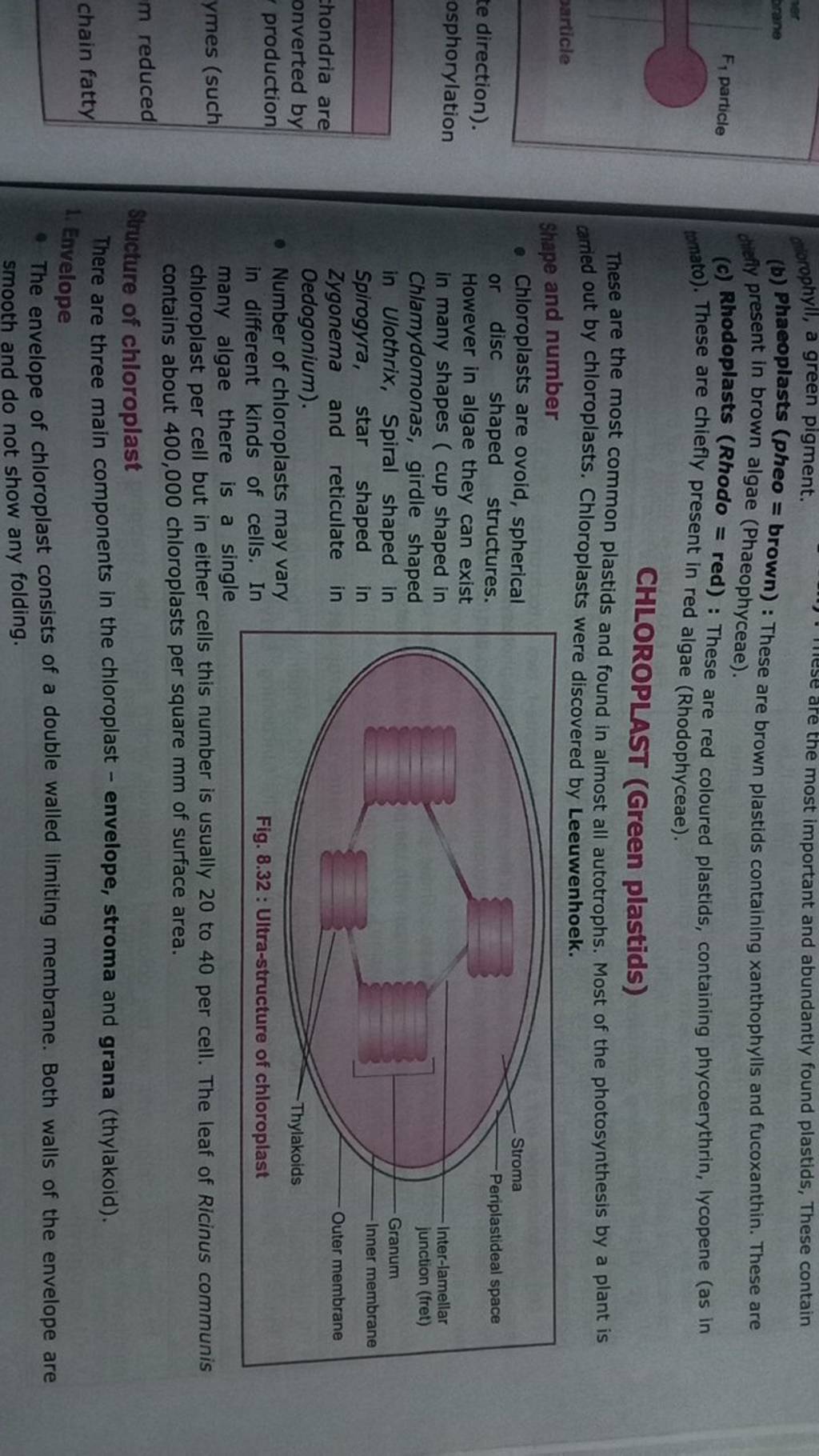Question
Question asked by Filo student

(b) Phaeoplasts (pheo = brown) : These are brown plastids containing xanthophylls and fucoxanthin. These are ditfly present in brown algae (Phaeophyceae). (c) Rhodoplasts (Rhodo red) : These are red coloured plastids, containing phycoerythrin, Iycopene (as in tomato). These are chiefly present in red algae (Rhodophyceae). CHLOROPLAST (Green plastids) These are the most common plastids and found in almost all autotrophs. Most of the photosynthesis by a plant is caried out by chloroplasts. Chloroplasts were discovered by Leeuwenhoek. Shape and number - Chloroplasts are ovoid, spherical or disc shaped structures. However in algae they can exist in many shapes ( cup shaped in Chlamydomonas, girdle shaped in Ulothrix, Spiral shaped in Spirogyra, star shaped in Zygonema and reticulate in Dedogonium). - Number of chloroplasts may vary in different kinds of cells. In many algae there is a single chloroplast per cell but in either cells this number is usually 20 to 40 per cell. The leaf of Ricinus communis contains about 400,000 chloroplasts per square of surface area. Structure of chloroplast There are three main components in the chloroplast - envelope, stroma and grana (thylakoid). 1. Envelope - The envelope of chloroplast consists of a double walled limiting membrane. Both walls of the envelope are smooth and do not show any folding.
Found 4 tutors discussing this question
Discuss this question LIVE
6 mins ago

One destination to cover all your homework and assignment needs
Learn Practice Revision Succeed

Instant 1:1 help, 24x7
60, 000+ Expert tutors

Textbook solutions
Big idea maths, McGraw-Hill Education etc

Essay review
Get expert feedback on your essay

Schedule classes
High dosage tutoring from Dedicated 3 experts
Practice more questions on Cell: Structure and Functions
Question 2
Easy
Views: 5,586
Students who ask this question also asked
Question 1
Views: 5,308
Question 2
Views: 5,561
Question 3
Views: 5,871


Stuck on the question or explanation?
Connect with our Biology tutors online and get step by step solution of this question.
231 students are taking LIVE classes
| Question Text | (b) Phaeoplasts (pheo = brown) : These are brown plastids containing xanthophylls and fucoxanthin. These are ditfly present in brown algae (Phaeophyceae).
(c) Rhodoplasts (Rhodo red) : These are red coloured plastids, containing phycoerythrin, Iycopene (as in tomato). These are chiefly present in red algae (Rhodophyceae).
CHLOROPLAST (Green plastids)
These are the most common plastids and found in almost all autotrophs. Most of the photosynthesis by a plant is caried out by chloroplasts. Chloroplasts were discovered by Leeuwenhoek.
Shape and number
- Chloroplasts are ovoid, spherical or disc shaped structures. However in algae they can exist in many shapes ( cup shaped in Chlamydomonas, girdle shaped in Ulothrix, Spiral shaped in Spirogyra, star shaped in Zygonema and reticulate in Dedogonium).
- Number of chloroplasts may vary in different kinds of cells. In many algae there is a single chloroplast per cell but in either cells this number is usually 20 to 40 per cell. The leaf of Ricinus communis contains about 400,000 chloroplasts per square of surface area.
Structure of chloroplast
There are three main components in the chloroplast - envelope, stroma and grana (thylakoid).
1. Envelope
- The envelope of chloroplast consists of a double walled limiting membrane. Both walls of the envelope are smooth and do not show any folding. |
| Updated On | Jan 2, 2023 |
| Topic | Cell: Structure and Functions |
| Subject | Biology |
| Class | Class 11 |
| Answer Type | Video solution: 1 |
| Upvotes | 66 |
| Avg. Video Duration | 3 min |



